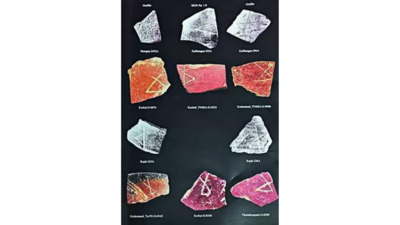- News
- India News
- Graffiti in ancient Tamil Nadu sites similar to Indus Valley civilisation signs: Study
Trending
Graffiti in ancient Tamil Nadu sites similar to Indus Valley civilisation signs: Study
A Tamil Nadu archaeology department study found over 90% of ancient graffiti marks at 140 sites, including Keeladi, resemble Indus Valley civilisation symbols. Researchers analyzed 15,184 graffiti signs, noting links between Indus and south Indian signs. The study suggests cultural exchanges during the Copper and Iron Ages. Key symbols included arrows, fish signs, and swastikas.
CHENNAI: A study by the Tamil Nadu archaeology department has revealed that more than 90% of the ancient graffiti marks found at 140 archaeological sites in the state, including Keeladi, have parallels or similarities with those of the Indus Valley civilisation that existed from around 3300 BCE to 1300 BCE.
Researchers analyzed 15,184 graffiti signs inscribed on potsherds unearthed from these sites, discovering that some signs had exact parallels while others had near similarities. "The exact shapes and their variants found in south India and Indus scripts indicate that they were not accidental," said archaeologist K Rajan, one of the report's authors. He said the Indus script or signs likely evolved over time rather than disappearing without a trace.
The study highlighted several common symbols between southern India and Indus Valley (also known as the Harappan civilisation), including upward-facing arrows with triangle or flower-shaped heads, fish signs in both stylish and exact forms, U- shaped signs, plain circles, ladder symbols, square boxes (plain and divided), X-shaped signs, and swastika-like signs in both clockwise and anti-clockwise forms.
Other common marks included flower signs, inverted Y-like signs, Z-like signs, A-like signs, and star signs.
"The recent radiocarbon dates indicate that when the Indus Valley experienced the Copper Age, south India was in the Iron Age. In this sense, the Iron Age of south India and the Copper Age of the Indus were contemporary. If they are contemporary, there is a possibility of cultural exchanges either through direct or intermediate zones," Rajan said.
Excavations at sites like Sivagalai, Adhichanallur, and other locations in Tamiraparani river basin have provided recent iron dating that may push back the timeline of the Iron Age in southern India by several centuries. Rajan highlighted the importance of documenting the graffiti inscribed potsherds, saying this documentation would be made available to researchers for further deciphering.
Archaeology department joint director R Sivanantham, who is a co-author of the report, said: "The occurrence of a large number of carnelian and agate beads, as well as high-tin bronze objects, particularly from Iron Age graves, gives a clue about the contacts as carnelian, agate, copper, and tin have to come from the north."
End of Article
FOLLOW US ON SOCIAL MEDIA
Visual Stories
Hot Picks
TOP TRENDING
Explore Every Corner
Across The Globe











